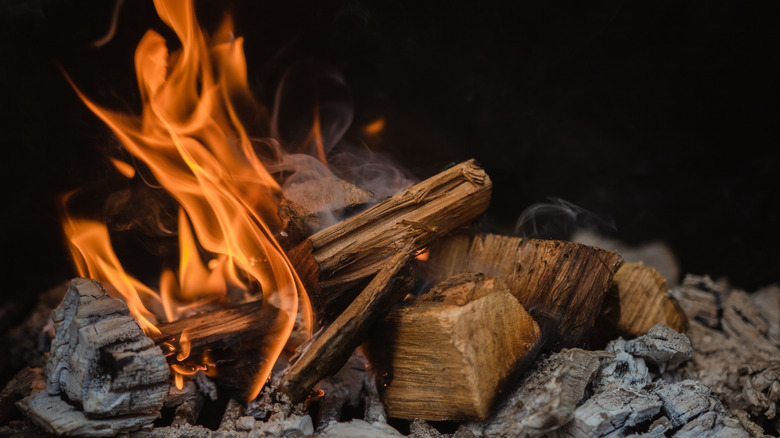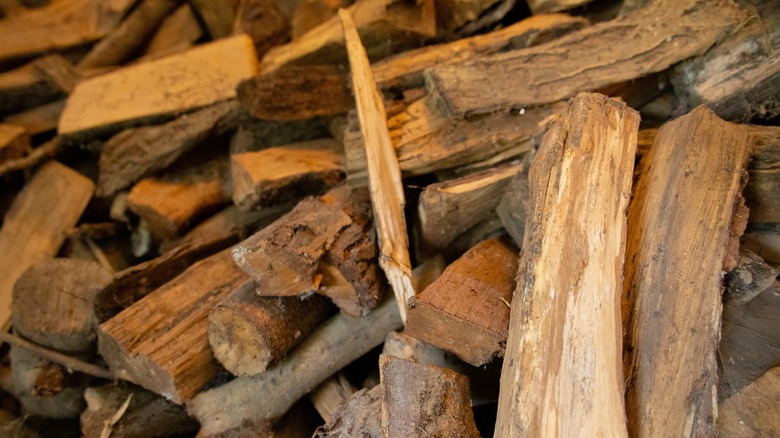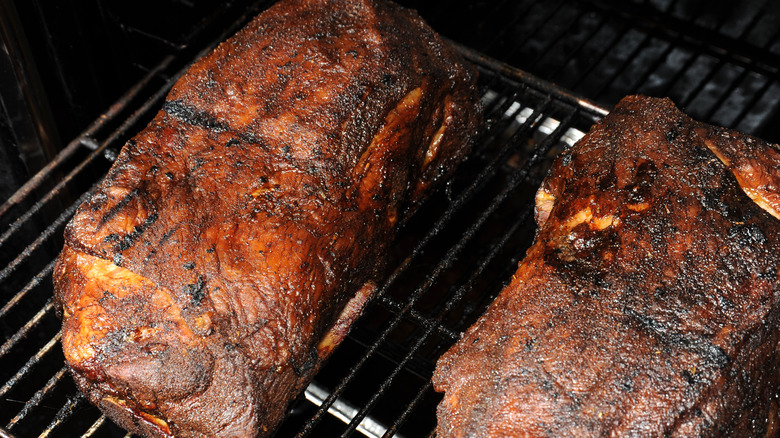If You're Smoking Meat, Are Wood Chips Or Wood Chunks The Way To Go?
If you've recently acquired a smoker (or have a grill with some pretty darn good temperature controls) and have familiarized yourself with the best cuts of meat to smoke, you might wonder: is it better to use wood chips or chunks to get the job done? The answer depends on how long the process is going to take. Any smoking job that's less than 30 minutes (and, let's face it, these would likely belong in the grilling category) is well-suited for wood chips, at least once they're soaked in water for at least an hour. If you're undertaking a smoking project that will take longer — and this holds true for cooking any larger cuts like a smoked Texas BBQ brisket or pork shoulder — stick to using wood chunks.
The simple reason for doing this is that wood chunks last longer. Once wood chips dry out after a half hour or so, they stop smoking and burst into flames. Needless to say, this not only depletes your smoke source, but it also dramatically raises the internal temperature of your smoker, threatening to ruin a process that typically relies on maintaining a consistently low temperature well below 300 degrees Fahrenheit. There's a reason it's called a smoker and not a burner. What do chunks do that chips can't?
Smoking the chunky way
Wood chunks are just that — pieces of hardwood that can be anywhere from the size of your palm to four inches in length. Unlike chips, it's not necessary to soak wood chunks prior to use. Generally speaking, wood chunks should be considered a source of smoke and not heat. (This, of course, is a break from tradition: If you're lucky, you can still come across some kinds of barbecue cooked over an open pit filled with hickory wood.) Even if you're using a wood-fueled grill or smoker, it's better to let charcoal do the heavy heat lifting and use hardwood chunks for aroma and flavor.
Because of this, make sure your smoker's heat source is up and running before adding the hardwood chunks — and when you do, it's best to place them on direct heat, like hot charcoal. The goal here is not to have a blazing hot environment; a good barbecued brisket should take hours, so this necessitates operating at a much lower temperature. The goal is to keep the wood chunks in the dehydration stage, where they'll produce lots of smoke. Once they get above 500 degrees Fahrenheit, they'll catch fire.
What is wood smoke and why is it so delicious?
Smoke, like fire, is not as straightforward as it seems. It is a gaseous amalgamation of 100 or so organic compounds, two being of primary interest to the home smoker: syringol and guaiacol. To radically oversimplify their chemical intricacies, syringol makes food smell smoky, while guaiacol makes it taste smoky. But it's the nature of this smell and taste that makes smoking meat such a delightful art, as it provides many wonderful opportunities for pairing with different types of meat.
There are robust woods like hickory and mesquite, often used for robust meats like beef and pork. (Mesquite, while delicious, is a beast and should be used sparingly lest it dominate the dish.) Pecan, a type of hickory, is great for game meats. Aromatic fruit woods like cherry, apple, and pear go wonderfully with poultry, as well as more assertively-flavored seafood like salmon. Lastly, there are balanced smoking woods like alder — delicate and a little sweet, they make an excellent smoke for fish like trout. Alder wood and salmon are also a dynamite combination. The only way to find more great wood-and-meat combinations is to smoke 'em out.


